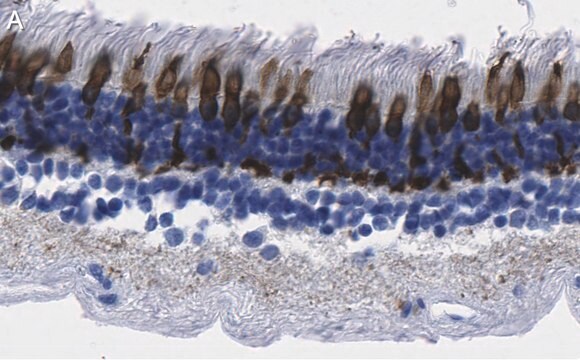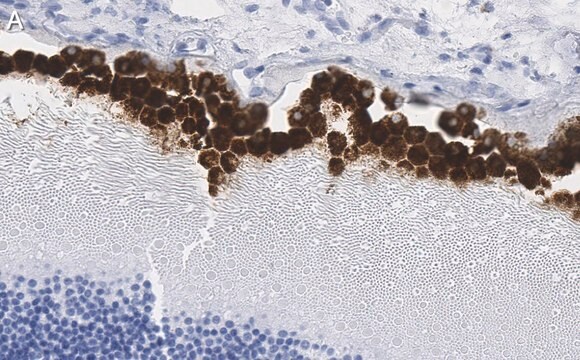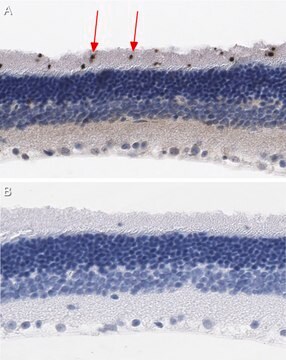一般說明
We are committed to bringing you greener alternative products, which adhere to one or more of The 12 Principles of Green Chemistry.This antibody is Preservative-free, produced without the harm or sacrifice of animals and exceptionally stable to allow for ambient shipping and storage if needed and thus aligns with "Waste Prevention", "Designing Safer Chemicals" and "Design for Energy Efficiency".
Click here for more information.
ZooMAb® antibodies represent an entirely new generation of recombinant monoclonal antibodies.Each ZooMAb® antibody is manufactured using our proprietary recombinant expression system, purified to homogeneity, and precisely dispensed to produce robust and highly reproducible lot-to-lot consistency. Only top-performing clones are released for use by researchers. Each antibody is validated for high specificity and affinity across multiple applications, including its most commonly used application. ZooMAb® antibodies are reliably available and ready to ship when you need them.
特異性
Clone 1C11 is a ZooMAb® Rabbit recombinant monoclonal antibody that specifically detects Short-wave-sensitive opsin 1. It targets an epitope within 17 amino acids from the C-terminal region.
免疫原
KLH-conjugated linear peptide corresponding to 17 amino acids from the C-terminal region of murine short-wave-sensitive opsin 1 (S-Opsin).
應用
Quality Control Testing
Evaluated by Western Blotting in Mouse retina tissue lysate.
Western Blotting Analysis: A 1:1,000 dilution of this antibody detected S-Opsin in Mouse retina tissue lysate.
Tested Applications
Immunohistochemistry (Paraffin) Analysis: A 1:1,000 dilution from a representative lot detected S-Opsin in mouse retina tissue sections.
Affinity Binding Assay: A representative lot of this antibody bound S-Opsin peptide with a KD of 2.8 x 10-8 in an affinity binding assay.
Immunofluorescence Analysis: A 1:1,000 dilution from a representative lot detected S-Opsin in mouse retina tissue sections.
Immunofluorescence Analysis: A 1:500 dilution from a representative lot detected S-Opsin in B6 wild type mouse retina (Courtesy of Dr Kang Li and Dr Mandeep Singh, Wilmer Eye Institute, Johns Hopkins University School of Medicine).
Immunocytochemistry Analysis: A 1:100 dilution from a representative lot detected S-Opsin in C6 cells.
Note: Actual optimal working dilutions must be determined by end user as specimens, and experimental conditions may vary with the end user.
標靶描述
Short-wave-sensitive opsin 1 (UniProt: P51491; also known as S opsin, Blue cone photoreceptor pigment, Blue-sensitive opsin, BOP, Short wavelength-sensitive cone opsin) is encoded by the Opn1sw (also known as Bcp) gene (Gene ID: 12057) in murine species. Opsins are G-protein coupled protein with photoreceptor activity. Opsins contain seven transmembrane -helical domains connected by three extra-cellular and three cytoplasmic loops. They are light-sensitive proteins found in photoreceptor cells of the retina. Based on sequence homology, the opsins are classified into six subfamilies: the vertebrate opsin/encephalopsin subfamily, the Go opsin subfamily, the Gs opsin subfamily, the invertebrate Gq opsin subfamily, the photoisomerase subfamily, and the neuropsin subfamily. They share less than 20 percent identity between subfamilies. Opsins provide the necessary environment for the absorption of light at a particular wavelength. Therefore, by providing a different opsin to the retinal, organisms can sense light of different wavelengths. S-opsin is a multi-pass membrane protein that is expressed in cone photoreceptor cells. It is a light-absorbing molecule that mediates vision and contains an apoprotein, opsin, which is covalently linked to cis-retinal. It can increase spectral sensitivity in dim light. This ZooMAb® recombinant monoclonal antibody, generated by our propriety technology, offers significantly enhanced specificity, affinity, reproducibility, and stability over conventional monoclonals. (Ref.: Daniele, L., et al. (2011). Vision Res. 51(4); 447-458; Applebury, ML., et al. (2000). Neuron. 27(3); 513-523).
外觀
Purified recombinant rabbit monoclonal antibody IgG, lyophilized in PBS, 5% Trehalose, normal appearance a coarse or translucent resin. The PBS/trehalose components in the ZooMAb formulation can have the appearance of a semi-solid (bead like gel) after lyophilization. This is a normal phenomenon. Please follow the recommended reconstitution procedure in the data sheet to dissolve the semi-solid, bead-like, gel-appearing material. The resulting antibody solution is completely stable and functional as proven by full functional testing. Contains no biocide or preservatives, such as azide, or any animal by-products. Larger pack sizes provided as multiples of 25 μL.
重構
300 μg/mL after reconstitution at 25 μL per vial. Please refer to guidance on suggested starting dilutions and/or titers per application and sample type.
儲存和穩定性
Recommend storage of lyophilized product at 2-8°C; Before reconstitution, micro-centrifuge vials briefly to spin down material to bottom of the vial; Reconstitute each vial by adding 25 μL of filtered lab grade water or PBS; Reconstituted antibodies can be stored at 2-8°C, or -20°C for long term storage. Avoid repeated freeze-thaws.
法律資訊
ZooMAb is a registered trademark of Merck KGaA, Darmstadt, Germany
免責聲明
Unless otherwise stated in our catalog or other company documentation accompanying the product(s), our products are intended for research use only and are not to be used for any other purpose, which includes but is not limited to, unauthorized commercial uses, in vitro diagnostic uses, ex vivo or in vivo therapeutic uses or any type of consumption or application to humans or animals.










